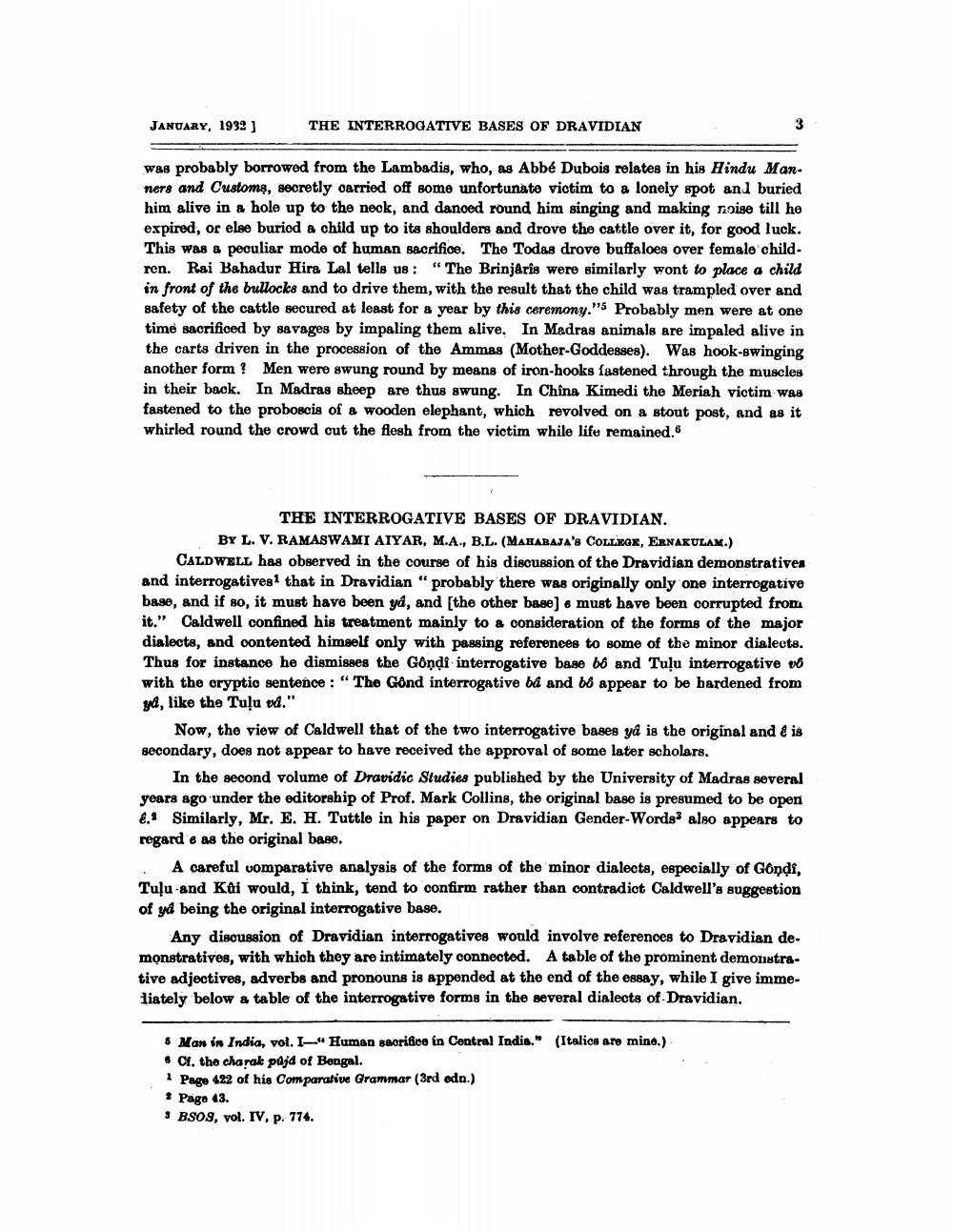Book Title: Indian Antiquary Vol 61 Author(s): Richard Carnac Temple, Charles E A W Oldham, S Krishnaswami Aiyangar, Devadatta Ramkrishna Bhandarka Publisher: Swati Publications View full book textPage 9
________________ JANUARY, 1932] THE INTERROGATIVE BASES OF DRAVIDIAN was probably borrowed from the Lambadis, who, as Abbé Dubois relates in his Hindu Man. ners and Customs, secretly carried off some unfortunate victim to a lonely spot and buried him alive in a hole up to the neck, and danoed round him singing and making noise till he expired, or else buriod a child up to its shoulders and drove the cattle over it, for good luck. This was a peculiar mode of human sacrifice. The Todas drove buffaloes over female child ren. Rai Bahadur Hira Lal tells us : "The Brinjêrîs were similarly wont to place a child in front of the bullocks and to drive them, with the result that the child was trampled over and safety of the cattle secured at least for a year by this ceremony." Probably men were at one time sacrificed by savages by impaling them alive. In Madras animals are impaled alive in the carts driven in the procession of the Ammas (Mother-Goddesses). Was hook-swinging another form? Men were swung round by means of iron-hooks fastened through the muscles in their back. In Madras sheep are thus swung. In China Kimedi the Meriah victim was fastened to the proboscis of & wooden elephant, which revolved on a stout post, and as it whirled round the crowd cut the flesh from the victim while life remained. THE INTERROGATIVE BASES OF DRAVIDIAN. BY L. V. RAMASWAMI AIYAR, M.A., B.L. (MAHARAJA'S COLLEGE, ERNAKULAM.) CALDWELL has observed in the course of his discussion of the Dravidian demonstratives and interrogatives that in Dravidian "probably there was originally only one interrogative base, and if so, it must have been yd, and [the other base] & must have been corrupted from it." Caldwell confined his treatment mainly to a consideration of the forms of the major dialects, and contented himself only with passing references to some of the minor dialects. Thus for instance he dismisses the Gôndi interrogative base 66 and Tuļu interrogative vo with the cryptio sentence: “The Gônd interrogative bd and b8 appear to be bardened from yd, like the Tuļu vd." Now, the view of Caldwell that of the two interrogative bases ya is the original and é is secondary, does not appear to have received the approval of some later scholars. In the second volume of Dravidic Studies published by the University of Madras several years ago under the editorship of Prof. Mark Collins, the original base is presumed to be open 6. Similarly, Mr. E. H. Tuttle in his paper on Dravidian Gender-Wordss also appears to regard e as the original base. A careful womparative analysis of the forms of the minor dialects, especially of Gondi, Tulu and Kai would, I think, tend to confirm rather than contradict Caldwell's suggestion of yd being the original interrogative base. Any discussion of Dravidian interrogatives would involve references to Dravidian demonstratives, with which they are intimately connected. A table of the prominent demonstrative adjectives, adverbs and pronouns is appended at the end of the essay, while I give immeliately below a table of the interrogative forms in the several dialects of Dravidian. (Italics are mine.) 6 Nan in India, vol. — Human sacrifice in Central India." 6 C4, the charak pajd of Bengal. * Page 422 of his Comparative Grammar (3rd odn.) 2 Page 43. 3 BSO9, vol. IV, p. 774.Page Navigation
1 ... 7 8 9 10 11 12 13 14 15 16 17 18 19 20 21 22 23 24 25 26 27 28 29 30 31 32 33 34 35 36 37 38 39 40 41 42 43 44 45 46 47 48 49 50 51 52 53 54 55 56 57 58 59 60 61 62 63 64 65 66 67 68 69 70 71 72 73 74 75 76 77 78 79 80 81 82 83 84 85 86 87 88 89 90 91 92 ... 428
